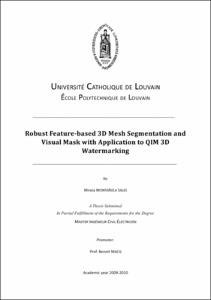Mostra el registre d'ítem simple
Robust feature-based 3D mesh segmentation and visual mask with application to QIM 3D watermarking
| dc.contributor | Ruiz Boqué, Sílvia |
| dc.contributor.author | Montañola Sales, Mireia |
| dc.date.accessioned | 2010-07-30T11:15:16Z |
| dc.date.available | 2010-07-30T11:15:16Z |
| dc.date.issued | 2010-07-07 |
| dc.identifier.uri | http://hdl.handle.net/2099.1/9567 |
| dc.description | The last decade has seen the emergence of 3D meshes in industrial, medical and entertainment applications. Many researches, from both the academic and the industrial sectors, have become aware of their intellectual property protection arising with their increasing use. The context of this master thesis is related to the digital rights management (DRM) issues and more particularly to 3D digital watermarking which is a technical tool that by means of hiding secret information can offer copyright protection, content authentication, content tracking (fingerprinting), steganography (secret communication inside another media), content enrichment etc. Up to now, 3D watermarking non-blind schemes have reached good levels in terms of robustness against a large set of attacks which 3D models can undergo (such as noise addition, decimation, reordering, remeshing, etc.). Unfortunately, so far blind 3D watermarking schemes do not present a good resistance to de-synchronization attacks (such as cropping or resampling). This work focuses on improving the Spread Transform Dither Modulation (STDM) application on 3D watermarking, which is an extension of the Quantization Index Modulation (QIM), through both the use of the perceptual model presented, which presents good robustness against noising and smoothing attacks, and the the application of an algorithm which provides robustness noising and smoothing attacks, and the the application of an algorithm which provides robustness against reordering and cropping attacks based on robust feature detection. Similar to other watermarking techniques, imperceptibility constraint is very important for 3D objects watermarking. For this reason, this thesis also explores the perception of the distortions related to the watermark embed process as well as to the alterations produced by the attacks that a mesh can undergo. |
| dc.language.iso | eng |
| dc.publisher | Universitat Politècnica de Catalunya |
| dc.rights | Attribution-NonCommercial-NoDerivs 3.0 Spain |
| dc.rights.uri | http://creativecommons.org/licenses/by-nc-nd/3.0/es/ |
| dc.subject | Àrees temàtiques de la UPC::Recursos generals::Legislació i normativa |
| dc.subject.lcsh | Copyright |
| dc.subject.other | Digital Rights Management |
| dc.subject.other | 3D watermarking |
| dc.subject.other | Copyright protection |
| dc.subject.other | Spread Transform Dither Modulation |
| dc.title | Robust feature-based 3D mesh segmentation and visual mask with application to QIM 3D watermarking |
| dc.type | Bachelor thesis |
| dc.subject.lemac | Propietat intel·lectual |
| dc.subject.lemac | Protecció de dades |
| dc.rights.access | Open Access |
| dc.date.updated | 2010-07-30T05:12:43Z |
| dc.audience.educationlevel | Estudis de primer/segon cicle |
| dc.audience.mediator | Escola Politècnica Superior de Castelldefels |
| dc.audience.degree | ENGINYERIA DE TELECOMUNICACIÓ (Pla 2001) |


